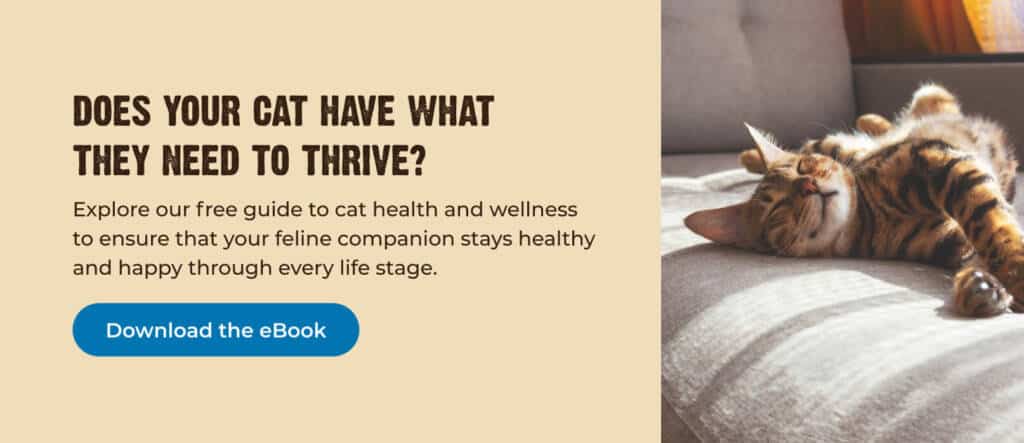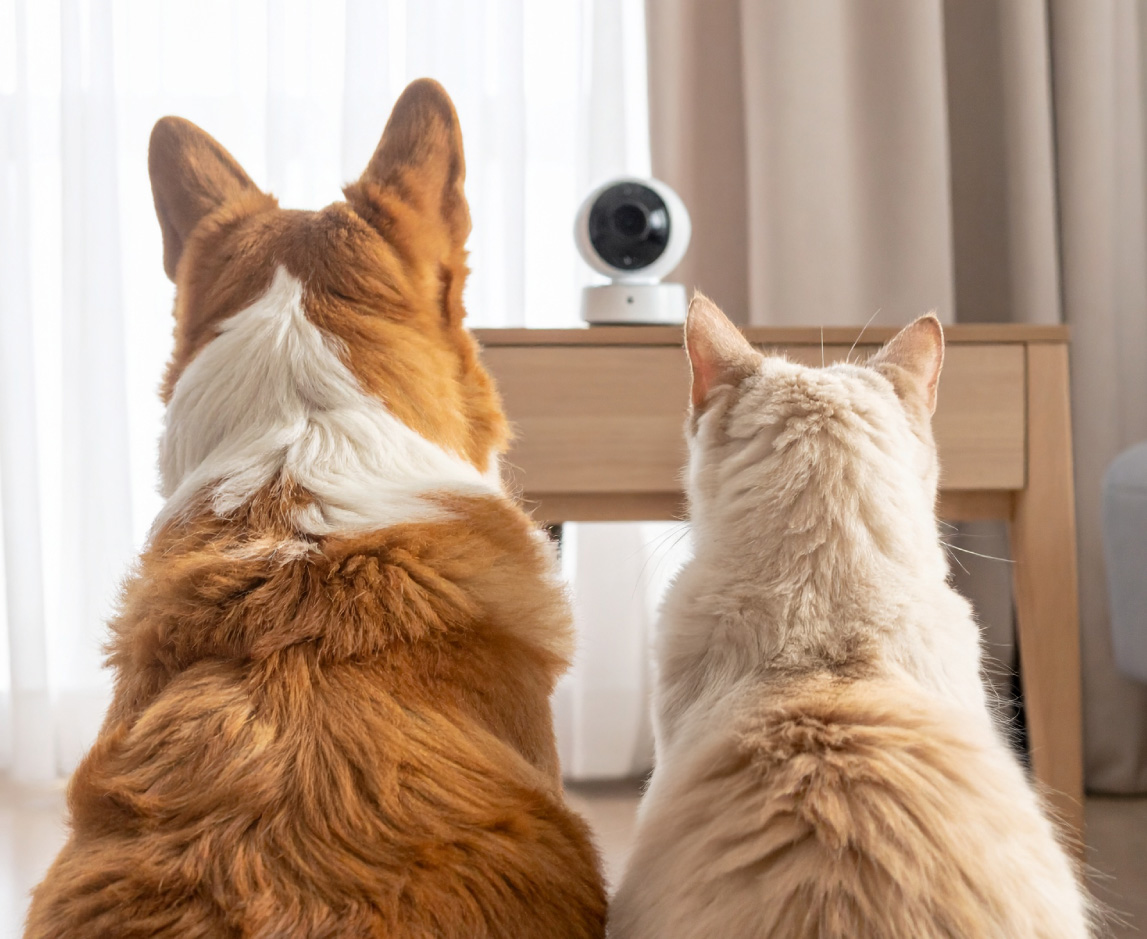Dental care for cats is a critical component of feline health. Unfortunately for pet owners, our furry friends cannot tell us when they are in pain, so it is important that we know signs to watch for. Dental issues are one of the most common conditions suffered by cats due to the anatomy of their teeth and their inability to clean them.
So, how can you help? Read below to learn more about the importance of dental care for cats, signs and symptoms of issues and how to prevent dental issues.
Importance of Dental Care for Cats
Cats are obligate carnivores, which means they thrive on meat-based diets. Because of this, their teeth are designed to grip and bite into the flesh of their prey. The unique shape of these sharp teeth allows food to sit in the mouth, which can cause numerous dental issues that lead to pain, swelling and other issues. The wild ancestors of domestic cats cleaned their teeth by chewing on their prey's bones, but this is no longer a viable option for feline family members.
According to Cornell College of Veterinary Medicine, studies report that between 50 and 90% of cats older than four suffer some form of dental disease. As plaque continues to build up, it can evolve into gingivitis, tooth resorption, periodontitis etc. These conditions could prevent a cat from maintaining a healthy diet. Even worse, If the bacteria enters the bloodstream, it could damage their kidneys or other vital organs. Because cats cannot always tell us they are in pain, it is crucial to regularly check your cat’s teeth and gums to ensure they are looking healthy. The good news is, there are a few options for preventing as well as treating dental issues.
Common Dental Diseases in Cats
There are three main diseases that commonly affect cats. Gingivitis, periodontitis, and tooth resorption. Oftentimes, preventing gingivitis can be key to preventing other dental diseases as most progress from gum inflammation. Visiting your veterinarian at the first sign of trouble will be paramount to your cat’s health.
- Gingivitis: Gingivitis is common in both felines and humans alike. This is a condition where the gums around the teeth become inflamed, resulting in swelling, redness, discomfort, and bleeding. This is usually caused by a reaction from the buildup of plaque in your cat’s mouth. In severe cases, untreated gingivitis can lead to periodontal disease and intense pain that leads to tooth removal. Cats with gingivitis may be hesitant to eat or show a preference for soft food. The best practice for gingivitis prevention includes tooth brushing with cat specific toothpaste (human toothpaste could be toxic to felines). Although your cat may absolutely hate getting their teeth brushed, you are doing them a favor in the long run. If your cat already has gingivitis, treatments include antibiotics, cleanings, or removing of teeth.
- Periodontitis: If your cat’s gingivitis has progressed out of control, it may be identified as periodontitis. This condition is worse than gingivitis because it means that the tissue attaching the tooth to the bone has been damaged. Symptom of periodontitis are the same as gingivitis (inflammation/bleeding). In addition to these symptoms, cats may turn their head to the side while chewing, drool or their tooth root surfaces will be exposed. Diagnosis will require x-rays and probing gums which requires anesthesia.
- Tooth Resorption: This is the most common cause of loss of feline teeth. Tooth resorption occurs when the tooth structures break down and may not be caused by gingivitis. Once the tooth is destroyed from the outside and inside, the sensitive parts of the tooth are exposed. This can lead to intense pain that will affect your cat’s quality of life.
Signs & Symptoms
Dental condition symptoms are not exclusive to one disease or another. Often, symptoms are generally the same. Here are some symptoms to look out for:
- Bad breath
- Refusal to eat/difficulty eating
- Only chewing on one side of the mouth
- Unusually swollen, bleeding or red gums
- Drooling
- Exposed tooth roots
- Tooth discoloration
- Tartar (visible at gum line)
How to Examine Your Cat's Teeth
Examining your feline’s teeth can be crucial to determining the health of their mouth. However, it may be tricky to get them to agree long enough for you to examine. Attempt to approach them when they are calm and begin by scratching their face. This will let you feel for bumps and put them at peace. If you find anything, veterinarians are more than happy to check for you.
If you can get your cat to allow you to examine them (maybe with the help of some treats), here are signs of healthy feline teeth:
- Clean teeth
- Teeth without any sort of chipping or indents
- No movement of teeth (gently push down one by one)
- No sores along gumline
- Pink gums with no swelling or bleeding
- No foul odor coming from their mouth
- No swelling, lesions or bumps in the back of their mouth
How to Prevent Dental Disease in Cats
So, you may be thinking “I know what to look for, now how do I prevent those symptoms?” There are a few things you can implement in your cat’s routine to help them stay healthy.
1. Dental Routine
Although your cat may strongly dislike getting their teeth brushed, it will become more natural as it becomes a routine. It is important to brush at least twice weekly if not daily, with the correct equipment. You can purchase a tooth cleaning kit for cats at your local vet’s office. Do not under any circumstances use human toothpaste on your cat. The fluoride in human toothpaste is toxic and will make them ill if they ingest it. There are also other options if brushing does not work such as sprays, water additives or treats.
2. Nutrition and Diet
Feeding your pet a well-balanced, healthy diet allows them to strengthen their immune system. A strong immune system will fend off bacterial infections and assist in overall healing. Additionally, styles of food can make a difference in your cat’s dental health. While soft wet food is beneficial for hydration, often it does not brush off food debris. On the other hand, dry kibble can help get rid of plaque but only if the cat chews it, as most cats swallow after one bite. For cats with dental disease, there are prescription diets that are meant to help. Consult your veterinarian to see if this may be the correct course of action.
3. Regular Check Ups
As always, it is recommended to regularly visit your veterinarian to get a full dental exam. That way, you can be sure there is nothing to worry about!
Dental Disease Treatment for Cats
Dental disease treatments will range depending on your cat’s condition. A veterinarian may encourage a professional cleaning, antibiotics/rinse, or a tooth extraction. Unfortunately, keeping your feline family member healthy can be costly, but these procedures are worth it to make sure they remain healthy. It is best to give your cat a professional cleaning every six months to once a year, and this can cost about $40 -190 each time.
The price depends on if they find any dental disease in your cat's mouth. But the alternative is even more costly. If disease goes untreated, your pet will be in pain and extraction can cost between $300 and $1,300. This is because extraction involves supplies, anesthesia, x-rays, and monitoring. The good news is that if you pay for pet insurance, your plan could be eligible for coverage.
Dental Diet & Foods for Cats
If your cat suffers from chronic dental issues, they may be put on a dental diet. This is a diet that is designed to get rid of plaque the way that cat’s ancestors once did. The pieces of food may be bigger and require chewing to cleanse the teeth. Other recommendations for keeping cat teeth clean include water additives, gels, dental chews or toys or a bone to chew on. Bones of pork, chicken and fish usually have splinters that could be harmful, it is important to make sure the bone is safe. Look for natural and non-toxic products that can stimulate the mouth.
Tips for Keeping Your Cat's Mouth Healthy!
1. Brush your cat’s teeth by cradling them from behind. Hold the chin and lift their lip.
2. Positive reinforcement will allow the cat to become more comfortable with this process.
3. If you do not have a cat toothbrush, you can use a fingertip with gauze. Some people prefer this as it gives them more control.
4. Watch for resistance to mouth handling (not uncommon but can mean pain is occurring).
5. Massages to your cat’s gums can strengthen them and help with healing.
6. Specially formulated treats can fight plaque and freshen breath, they also often contain vitamins.
7. Looking for dental products? Look here for a reliable source list.
8. Cat toothpastes come in many flavors! Chicken and fish are good options to try out first.
9. Sea Kelp can fight bacteria in the mouth and cats genuinely like it.
FAQs About Cat Dental Care
Q: How many teeth do cats have?
A: Good question! Kittens usually have 26 teeth, while older cats have around 30.
Q: What is the difference between plaque and tartar?
A: Plaque can be found on the teeth right after a feline eats. It is made up of food and bacteria. Tartar is the result of plaque sitting on the teeth for too long and hardening. Plaque can harden within 24 hours, creating tartar that is clearly visible and will eventually turn into disease.
Q: What is the best way to brush my cat’s teeth?
A: Create a dental routine with lots of positive reinforcement. It is best to start at an early age if possible. It may take a while for them to get used to having something in their mouths but eventually, they will fall into routine. Try different toothpaste flavors to see if that helps! Most importantly, do not give up too easily with pushing a routine.






